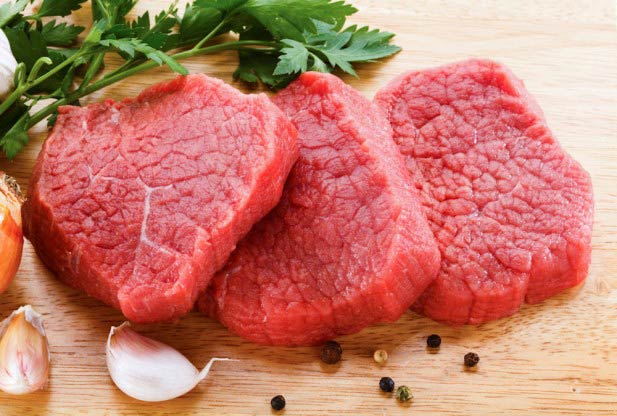After slaughtering, animal muscle turns to edible meat and it is surrounded by connective tissues, consisted mostly of protein collagen. There are three main components of meat tissues; fat, protein-based connective tissue and water. There’s also a smaller amount of carbohydrate that gives meat darker colors when it is cooked and also much of its desirable flavour. Meat is often grouped into two main categories, dark and white meat. In general, a meat is placed in the red category when it contains plenty of slow fibers. These muscles are useful for animals during repeated and extended sessions of activities, such as standing, walking and slow galloping.
Oxygen is stored in the protein myoglobin clusters and it is needed when we want to process energy for repeated activities. In general, myoglobin should be considered a richly-pigmented protein. The meat becomes darker or redder when there are more myoglobins. So, the more active the muscle is, the redder it will become. On the other hand, white meat is usually consisted of fast fibers that are needed for rapid bursts of activities, such as fleeing from predator. Energy is obtained from glycogen that’s present inside the muscles. Fish is the most obvious example of white meat with its translucent, glassy appearance when it is raw.
Although it is still somewhat debatable, pigs and calf is often grouped in the white meat category. Calf could still be milk-fed and its muscles haven’t been used for years. On the other hand, pigs are slow moving animals and they are not as active as other farmed animals. In this case, white meat is considered white because it is less often used as a muscle. In fact, the content of myoglobin could be particularly low in these types of muscles. Chicken breast is the “whitest” component compared to the other parts. Fish doesn’t support its weight under the water and doesn’t require myoglobin in the muscles.
It would be safer to say that pigs and chickens are a transition between dark and white meat. Pigs certainly have some myoglobin in the muscles, but the concentration may not be as significant. Chicken also has a mixture of white and red meat. Chickens are typically quite active, even when inside the cage. They often stand and move around, especially there are people nearby. The leg and thigh muscles of chicken are usually darker than the wings and breast. Wild birds in contrast, often fly for long distances and this causes their wings and breasts to turn darker. Ducks also swim a lot that makes their legs redder than the rest of the body.
Cows are a common example of red meat and they spend much of the time walking and standing. Compared to other meat, beef has particularly higher amount of myoglobin. Pigs spend much of their time roaming and standing around, so they also have some amount of myoglobin that causes pinkish colors of their meat. Both pigs and veal have less used muscles, so they should be considered as transition meats. It should be noted that some fast swimmers, such as tuna and shark (sharks are also edible) have red meat because they need to move much faster.































No Comments
Leave a comment Cancel